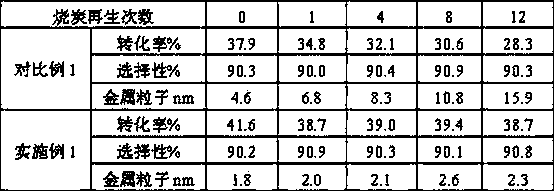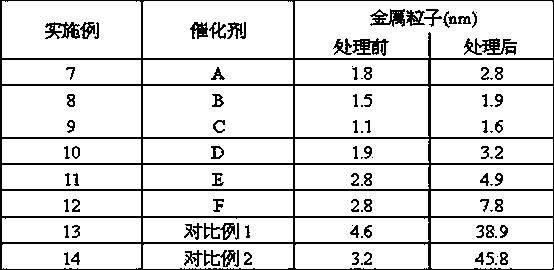Anti-sintering catalyst for preparing low-carbon olefin by low-carbon alkane dehydrogenation and preparation method thereof
A dehydrogenation catalyst, a technology for low-carbon alkanes, applied in the directions of hydrocarbons, hydrocarbons, chemical instruments and methods, etc., can solve the problems that affect the performance of catalysts, metal particles are not easy to aggregate and grow, and they are easy to aggregate and grow. Enhance anti-coking ability, inhibit cracking hydrogenolysis, high dispersion effect
- Summary
- Abstract
- Description
- Claims
- Application Information
AI Technical Summary
Problems solved by technology
Method used
Image
Examples
Embodiment 1
[0026] Get 60g aluminum nitrate (Al(NO 3 ) 3 9H 2 O) be dissolved in 200ml deionized water, then by the amount of substance Al:Mg is the mixed aqueous solution of 1:1 preparation aluminum nitrate solution and magnesium nitrate; o C, under vigorous stirring, slowly drop the mixed aqueous solution into 5% ammonia water to form a precipitate, control the pH value to be about 10, filter the precipitate at room temperature overnight, wash, and wash at 120 o C drying, crushing, sieving, at 700 o C was calcined for 3 hours to obtain composite alumina supports with different proportions.
[0027] The obtained composite alumina support is loaded with platinum and tin components by impregnation technology, that is, the obtained support is impregnated with chloroplatinic acid (H 2 PtCl 6 6H 2 O, 0.16g) and tin chloride (SnCl 4 5H 2 O, 0.18g) in aqueous solution (10ml) for 24 hours (metal platinum loading 0.4%, Pt:Sn=1:2), then 60 o C drying, 530 in air flow o C roasting f...
Embodiment 2
[0031] The carrier and catalyst were prepared according to the method of Example 1, except that the ratio of Al:Mg was 2:1, the loading of metal platinum was 0.5%, and the pH value of the precipitation was controlled to be about 9. The obtained catalyst was marked as B.
[0032]
Embodiment 3
[0034] Carrier and catalyzer are prepared by the method of embodiment 1, and difference is that precipitation pH value control is about 8, and chloroplatinic acid (H 2 PtCl 6 6H 2 O, 0.04g), the resulting catalyst is denoted as C.
[0035]
PUM
 Login to View More
Login to View More Abstract
Description
Claims
Application Information
 Login to View More
Login to View More - R&D
- Intellectual Property
- Life Sciences
- Materials
- Tech Scout
- Unparalleled Data Quality
- Higher Quality Content
- 60% Fewer Hallucinations
Browse by: Latest US Patents, China's latest patents, Technical Efficacy Thesaurus, Application Domain, Technology Topic, Popular Technical Reports.
© 2025 PatSnap. All rights reserved.Legal|Privacy policy|Modern Slavery Act Transparency Statement|Sitemap|About US| Contact US: help@patsnap.com


